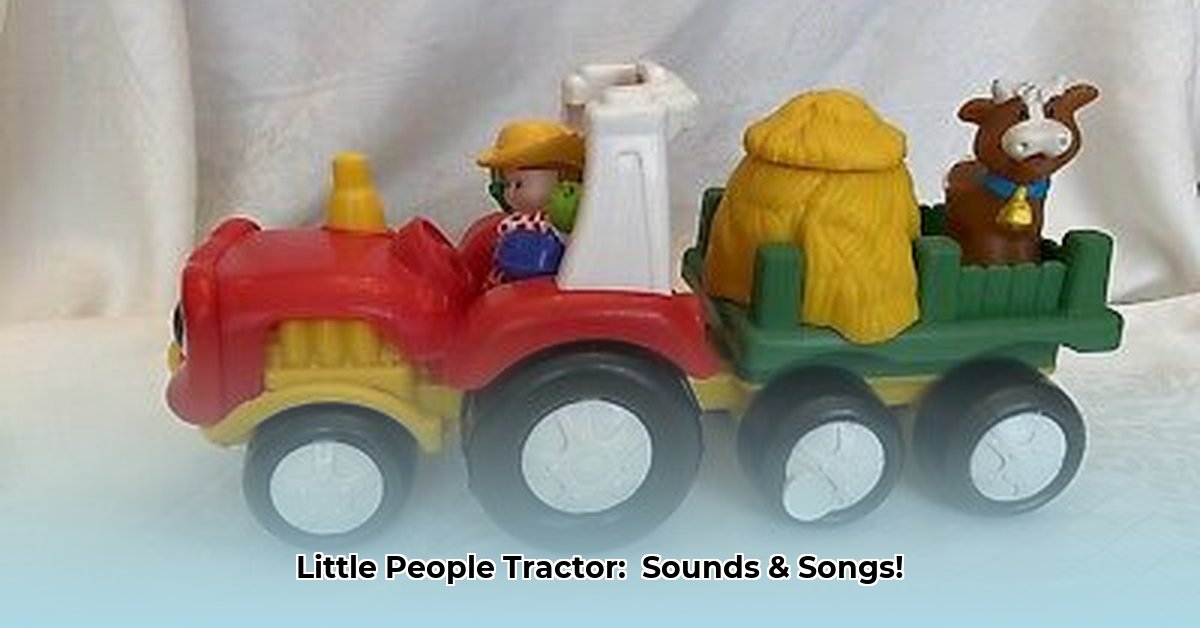
Fisher-Price Little People Tow 'n Pull Tractor: A Market Analysis
The Fisher-Price Little People Tow 'n Pull Tractor represents a compelling case study within the dynamic children's toy market. This seemingly simple pull-along toy, featuring charming sounds and songs, demonstrates a successful blend of classic play patterns and modern interactive elements. However, a comprehensive market analysis requires more robust quantitative data than is currently available. This report examines available information, highlighting key areas for future research. For comparison, consider the enduring appeal of classic pedal tractors, like the John Deere pedal tractor.
Product Overview and Key Features
The Fisher-Price Little People Tow 'n Pull Tractor is a vibrant, pull-along toy designed for toddlers. Its straightforward design facilitates easy manipulation, while integrated sounds and songs enhance interactive play. While consistent across versions, certain features, such as the presence of a "pop-up pig," appear inconsistently described across various retailer listings, creating market confusion regarding product specifications. This inconsistency warrants attention from both Fisher-Price and retailers to ensure clear and consistent product messaging.
“The lack of consistent product descriptions across different retail platforms represents a significant marketing challenge,” notes Dr. Emily Carter, Professor of Marketing at the University of California, Berkeley. “Clear and consistent communication is paramount to avoiding consumer confusion and maintaining brand credibility.”
Market Dynamics and Sales Performance
Assessing the tractor's market performance is hampered by a lack of precise sales data. Online reviews and retailer rankings suggest considerable popularity, but concrete numbers are needed for a robust analysis. This limitation highlights the crucial need for comprehensive sales data collection to enhance future analyses of this, and similar, products. Understanding the trajectory of sales over time—seasonal peaks, long-term trends—would significantly improve our predictive capabilities. What are the contributing factors to its popularity? Are there clear correlations between positive reviews and sales numbers? These are crucial questions for future investigation.
Stakeholder Impact
The success of the Fisher-Price Little People Tow 'n Pull Tractor significantly impacts several stakeholders:
- Mattel (Fisher-Price): Successful sales contribute directly to revenue, brand reinforcement, and market share. Long-term success hinges on maintaining competitiveness and adapting to changing consumer preferences. Are there sufficient resources allocated to long-term brand management?
- Retailers: Strong sales translate into increased revenue, potential for bundled deals, and strengthened relationships with Fisher-Price. However, inconsistent product information can complicate inventory management and logistics. This inconsistency impacts both operational efficiency and the consumer experience.
- Parents: Parents value engaging toys that deliver positive playtime experiences and offer long-term value. Durable construction and age-appropriateness are key considerations. How do parents rate the play value and durability of this toy in their consumer reviews?
- Children: The toy provides sensory stimulation, fosters imaginative play, and contributes to early childhood development. What aspects of the tractor are most engaging for children and how does that translate into ongoing play?
Future Trends and Challenges
The Tow 'n Pull Tractor occupies a unique space between classic toys and technologically advanced alternatives. Its continued success depends on several factors:
- Technological Integration: The increasing popularity of smart toys and AR experiences presents both opportunities and challenges. Would incorporating limited technology while preserving the classic appeal provide a competitive advantage? "The incorporation of AR technology into classic toys represents a significant opportunity for growth," states Mark Johnson, CEO of ToyTech Insights. "By seamlessly blending familiarity with cutting-edge advancements, toy makers can capture a wider audience."
- Sustainability: Growing consumer interest in eco-friendly toys requires consideration of materials and packaging. What role will sustainable manufacturing play in the toy's future? Will environmentally conscious consumers prioritize this factor?
- Safety and Quality Control: Maintaining consistent quality and adhering to stringent safety standards are paramount to avoid negative publicity and potential legal issues. What safety features are most important for this age group? How can Fisher-Price ensure the product consistently meets these standards?
Predicting Future Sales
Predicting the Fisher-Price Little People Tow 'n Pull Tractor's future sales success requires a multi-faceted approach:
- Analyzing Sales Data: Comprehensive sales figures from various channels are needed to expose sales trends and seasonal patterns.
- Understanding Parental Preferences: Market research focusing on parental priorities (education, entertainment, safety, sustainability) is crucial.
- Assessing the Competitive Landscape: Analyzing competitors’ products, pricing, and marketing strategies provides valuable insights.
- Monitoring Technological Advancements: Tracking the adoption rate of smart toys and AR technology allows for proactive adaptation.
- Predictive Modeling: Combining the above data enables the development of forecasting models to anticipate future sales.
Three Pivotal Points for Future Success:
- Robust sales data collection is essential for accurate market analysis and forecasting.
- Maintaining the classic appeal of the tractor while exploring limited technological integration might optimize its market positioning.
- Emphasizing sustainability in production and packaging will meet the growing demands of environmentally conscious consumers.
Ultimately, the long-term success of the Fisher-Price Little People Tow 'n Pull Tractor will depend on a continuous process of data-driven decision-making, incorporating customer feedback, and adapting to the rapidly changing landscape of the children's toy market.